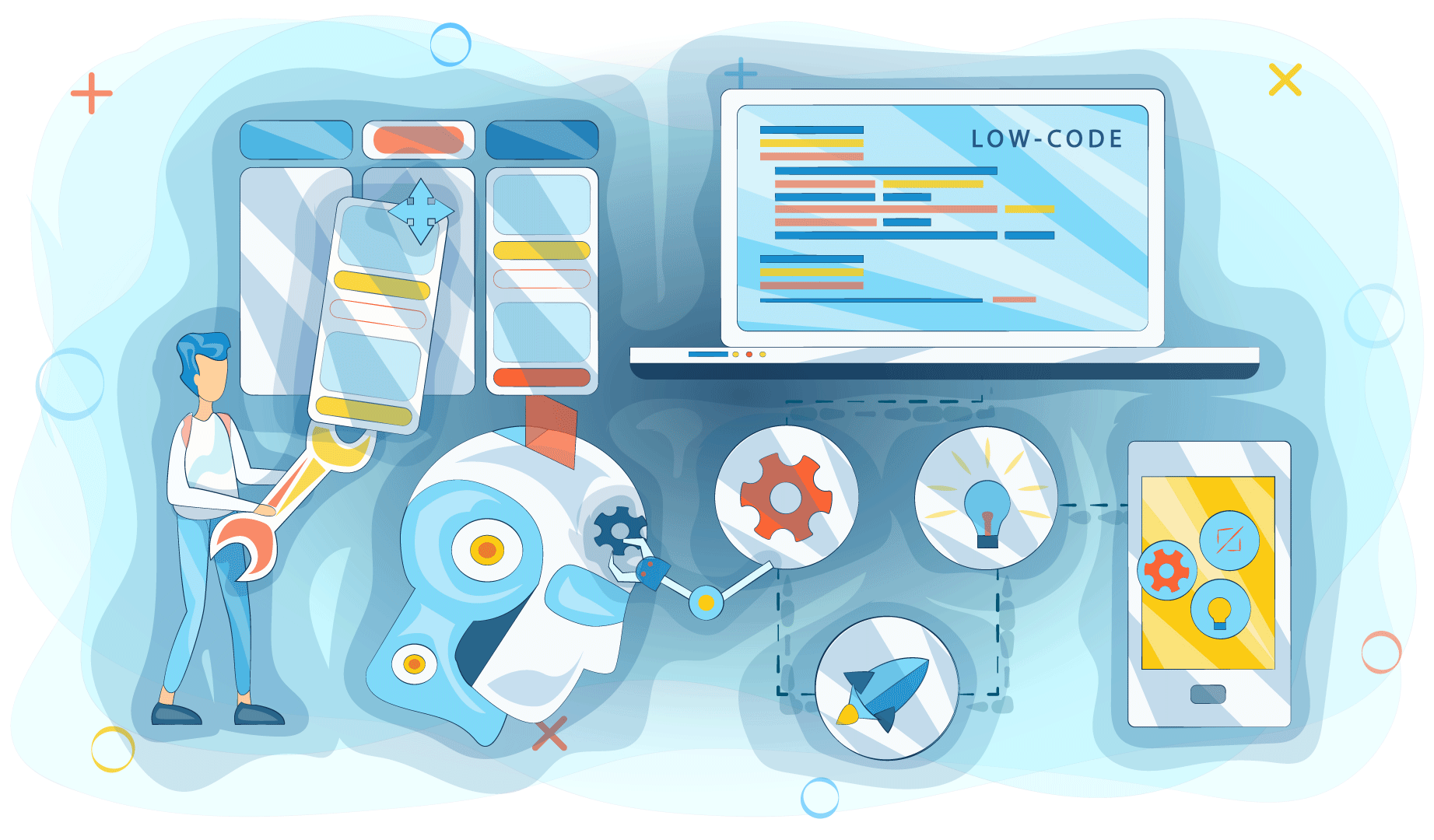Low-code is a new approach to creating, configuring applications and systems, which does not require writing program code. Such platforms use visual interfaces with simple logic and drag-and-drop functionality instead of different programming languages. These tools are understandable even for an ordinary user who does not have programming knowledge, which makes it possible to create applications for different purposes without professional help.
Main characteristics
Low-code is chosen by both professional developers and business users. The platform meets the current needs for automating business processes, accelerating digital transformation.
The following features of Low-code platforms are distinguished:
- Visual modeling. Software is developed using visual methods and models, which is much faster than development through writing code. Such platforms use built-in components that display information in an understandable format.
- Ready-made solutions. Low-code systems offer many out-of-the-box features, eliminating the need to create basic modules.
- Drag-and-drop function. Drag-and-drop is one of the most useful tools to simplify the development process.
- Modularity. Each module is responsible for solving its own problem and at the same time can be used in other applications.
- Versatility. First, the platform itself can operate in any software environment. Secondly, it can be used to create applications that are compatible with different operating systems that will work on different devices.
- Safety. A properly created Low-code platform meets all security requirements.
- Scalability. The system copes with the growing number of users, which is especially important for business projects.
- Application lifecycle management. The platform speeds up the software development cycle, simplifies application testing. It also makes it possible to transfer changes between environments.
In addition, industrial-level platforms make it possible not only to create unique IT solutions, but also to monitor their performance, process, and provide data for analyzing the operation of systems at the stage of their exploitation.
Design principles
Low-code is highly automated, but the processes for creating an application are not automatic. Low code projects also depend on the use of sound business principles.
First of all, you need to understand that such a platform does not perform all the work for the developer/user. For this reason, at first it makes sense to study what Low-code can do and what it offers.
The strong point of the platform lies in the predefined components that are carried over into the workflow. They are most often versatile and suitable for a wide variety of use cases. At the same time, if the components do not meet the needs of a specific task, you can add new ones.
For successful work, the entire team that uses the platform must clearly understand the requirements and global goals of the current project. Product owners must be able to answer questions and validate assemblies in environments.
Low code greatly simplifies the process of repetition and experimentation with new functionality. However, a project plan can be useful to keep development with a minimum amount of code.
What is Lowe-code used for?
Users can create and customize applications for a wide variety of tasks, from automating client processes to managing data. Low-code platform is used for different purposes, the main ones are the following:
- System for working with clients. A business user can customize unique solutions that increase sales, improve lead conversions, and improve the quality of service.
- A tool to improve operational efficiency. Using Low-code, it is possible to create applications that improve employee productivity. Automation will reduce the likelihood of errors, eliminate routine.
- Improving business processes. Business processes of any complexity can be automated, which will increase their effectiveness.
- Artificial intelligence solutions. Connecting a machine learning algorithm and other AI technologies will speed up the data processing process, minimize manual manipulations, and improve the quality of decision making.
Also, using simple but effective tools, you can customize the data structure, user interface and application logic for both the browser and mobile devices.
Top reasons to use the Low-code platform
There are many reasons, but let's highlight the main seven ones:
- The minimum time period from idea to implementation. Out of the box visual designers, printable templates, built-in connectors – all this helps to quickly create new applications.
- Reduced costs. Using Low-code does not require special knowledge and development experience, so there is no need to have a large staff of IT specialists. Simple tools allow users to independently implement settings.
- Improving customer experience. The platform allows you to quickly adapt to changes in the market and customer needs through the implementation of modern IT solutions or regular software updates.
- High level of security. The platform contains all the necessary tools for administration, threat assessment and access control.
- Control over IT infrastructure. Low-code allows employees of one company to create the desired functionality in a single information field, eliminating the need to use third-party applications.
- Effective collaboration between IT and business. The close connection between IT technology and business increases the effectiveness of the latter. The intuitive interface and powerful tools of the Low-code platform enable both business users and IT developers to speak the same language.
- Accelerating digital transformation. To remain in demand in the market, companies need to automate most of the processes. Low-code allows you to speed up the transformation cycle and implement innovations faster.
Thus, low code platforms can be used by both ordinary users and professional developers. They are applicable for large businesses and relevant for small companies that want to automate certain areas of work. The simplicity of Low-code tools allows even an average HR manager to use them.
The global pandemic forced many companies to urgently develop applications, portals, and automate workflows, which led to unforeseen expenses. The use of Low-code allows to minimize costs, but at the same time create applications for specific business goals. Low code platforms continue to evolve at a rapid pace, providing proper coding, testing, and error correction standards.

























